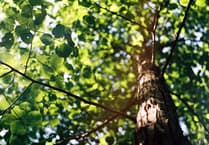WORK has begun to double the size of one of England's last remaining temperate rainforests.
The plan, which has been in the making for over two years, works with natural processes to expand Wistman’s Wood to bring about its increased resilience and enhance the surrounding areas.
Devon based charity Moor Trees collected acorns from Wistman’s Wood on Sunday after a special license was issued from Natural England; an initial step for the plan which is due to double the size of Wistman’s Wood by the early 2040s.
The Moor Trees volunteers spent the day collecting the acorns, which will then be taken to our nursery to germinate. The acorns along with the rowan seeds gathered last month from the site will stay at the nursery for two years before being brought back to the site and planted on the periphery of the woodland and the valley opposite.
The collection of acorns on Sunday will be an initial step in bolstering the existing woodland, helping to protect the genetic diversity found within. Wistman’s Wood is a very rare and special ecosystem, therefore it is important to plant trees that were grown from seed gathered from the site, to maintain the genetic qualities. By undertaking the work this Sunday, the Duchy is hoping to increase the size of the woodland, increasing its resilience and in turn, protecting the biodiversity.
Geraint Richards, Head Forester at The Duchy of Cornwall and to HM The King, says: 'Wistman’s Wood is a rare survivor of the type of woodland that would have once been commonplace on Dartmoor. We are excited to see this positive action taking place to expand this special habitat and look forward to seeing the gathered acorns germinate, grow and eventually be planted out to expand Wistman’s Wood.'
Wistman’s Wood is an ancient oak woodland which covers over three hectares of the West Dart Valley on Dartmoor, Devon. It is a National Nature Reserve (NNR), a Site of Special Scientific Interest (SSSI) and a Special Area of Conservation (SAC) in recognition of its significance for nature conservation. It is often referred to as one of the South West’s last remaining examples of temperate rainforest and this project is essential to carefully improving Wistman’s Wood’s resilience, where very rare Atlantic mosses and lichens reside in the small and isolated remnant. Resilience is a measure of how quickly an ecosystem can restore itself following disturbance, such as fire or disease. With climate change causing increased summer drought, increased winter rainfall and more extreme weather events, the world’s woodlands are becoming stressed making them more vulnerable to disturbance.




